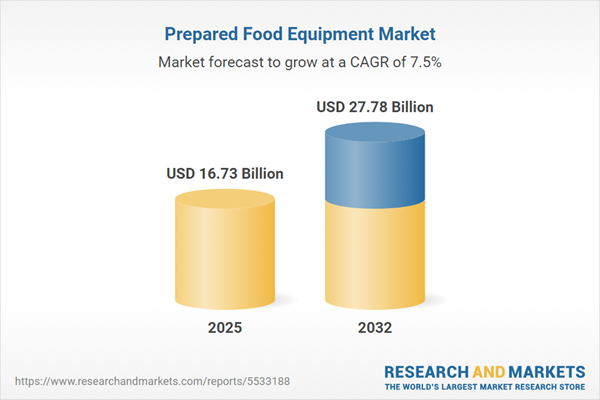Speak directly to the analyst to clarify any post sales queries you may have.
The prepared food equipment market is undergoing substantial transformation, driven by automation, shifting regulations, and changing consumer preferences. Senior leaders face increasing pressure to realign operational priorities and investment strategies to remain competitive in this evolving business environment.
Market Snapshot: Prepared Food Equipment Market Trends
The global prepared food equipment market was valued at USD 15.53 billion in 2024, with projections to reach USD 16.73 billion by 2025 and USD 27.78 billion by 2032. The compound annual growth rate is 7.53%. Automation integration and growing investment in modular system innovation are primary growth drivers. Leadership emphasis has shifted towards operational agility, allowing businesses to respond effectively to regulatory changes and dietary trends. Both established and emerging providers now prioritize adaptive, compliance-focused solutions, reshaping business models and intensifying international competition in the prepared food equipment market.
Scope & Segmentation of the Prepared Food Equipment Market
This section helps senior executives refine investment decisions, minimize risk, and secure strategic insight for long-term planning. Each segment provides actionable benchmarks for resource allocation and modernization.
- Equipment Types: Packaging machines, pre-processing equipment, and highly specialized systems are vital for workflow optimization across multiple food production categories, supporting both volume-driven and niche manufacturing needs.
- Modes of Operation: Organizations select between fully automated, semi-automatic, or manual systems, adapting to workforce skill levels and facility goals to maximize operational flexibility.
- Application Areas: Key sectors include bakery, dairy, confectionery, meat, seafood, ready meals, sauces, condiments, and snacks—each responding to evolving consumer dietary patterns and new product demands.
- Distribution Channels: Various routes to market include partnerships with domestic and international distributors, direct sales, OEM alliances, government contracts, and digital platforms designed to expand reach and strengthen supply security.
- Regional Coverage: Analysis includes major geographies such as the Americas, Europe, Middle East and Africa, and Asia-Pacific. Key economies like the US, China, Germany, India, and Brazil provide insight into unique consumption habits and regulatory factors affecting regional dynamics.
- Technology Focus: Digital automation, IoT-equipped devices, modular designs, advanced sensors, and energy-efficient technologies all contribute to enhanced uptime, superior monitoring, and continual compliance with food industry standards.
- Company Analysis: Competitive intelligence reviews strategies from leading and emerging players, emphasizing technology integration and adherence to global standards. Notable firms include Neologic Engineers, Alfa Laval, Bharti Refrigeration Works, JBT Corporation, and ITW Food Equipment Group.
Key Takeaways: Strategic Insights for Senior Decision-Makers
- Adopting modular automation promotes swift operational adaptation during regulatory shifts or changes in consumer demand.
- Integrating sustainability with process improvements enhances compliance, optimizes resources, and supports robust risk management frameworks.
- Modernizing with advanced technologies positions leadership to proactively address industry challenges and leverage opportunities across product categories.
- Diversifying supply networks and moving production nearer to core markets builds operational resilience, increasing stability against supply chain disruption.
- Customizing market strategies by geography and supplier profile streamlines market entry and eases compliance with diverse regulatory requirements.
- Strengthening collaborations with equipment and packaging partners accelerates innovation and improves responsiveness to customer and regulatory needs.
Tariff Impact: United States Developments in 2025
Forthcoming US tariffs on select prepared food equipment and crucial components are driving many companies to reassess sourcing methods and manufacturing footprints. Organizations are shifting toward localized production and enhancing supplier diversity to manage risks and ensure comprehensive contingency planning.
Methodology & Data Sources
This report draws on extensive secondary research, industry expert interviews, and in-depth analysis of corporate strategy documentation. Findings are cross-validated through triangulation and peer review to ensure accuracy and transparency for decision-makers.
Why This Report Matters
- Equips executives with actionable insights for investment and risk reduction in the transforming prepared food equipment sector.
- Enables companies to proactively address market disruptions, adapt supply chains, and remain compliant with emerging regulations and trends.
- Highlights opportunities for process improvements and collaboration across manufacturers and distribution networks throughout the industry.
Conclusion
Investing in technology, fostering strategic supplier alliances, and advancing sustainability help companies balance operational risk with market growth. Flexibility remains essential for sustained success in the prepared food equipment industry.
Additional Product Information:
- Purchase of this report includes 1 year online access with quarterly updates.
- This report can be updated on request. Please contact our Customer Experience team using the Ask a Question widget on our website.
Table of Contents
3. Executive Summary
4. Market Overview
7. Cumulative Impact of Artificial Intelligence 2025
Companies Mentioned
The companies profiled in this Prepared Food Equipment market report include:- Neologic Engineers Private Limited
- Alfa Laval Corporate AB
- Bharti Refrigeration Works
- Repute Engineers Pvt Ltd
- Kanchan Metals Pvt. Ltd.
- BAK Food Equipment
- JBT Corporation
- Sree Enterprise
- ITW Food Equipment Group
- The WEBstaurant Store, LLC
Table Information
| Report Attribute | Details |
|---|---|
| No. of Pages | 186 |
| Published | October 2025 |
| Forecast Period | 2025 - 2032 |
| Estimated Market Value ( USD | $ 16.73 Billion |
| Forecasted Market Value ( USD | $ 27.78 Billion |
| Compound Annual Growth Rate | 7.5% |
| Regions Covered | Global |
| No. of Companies Mentioned | 11 |









